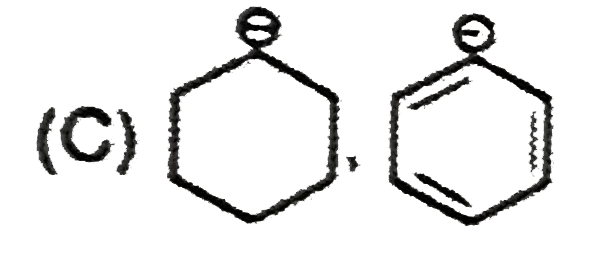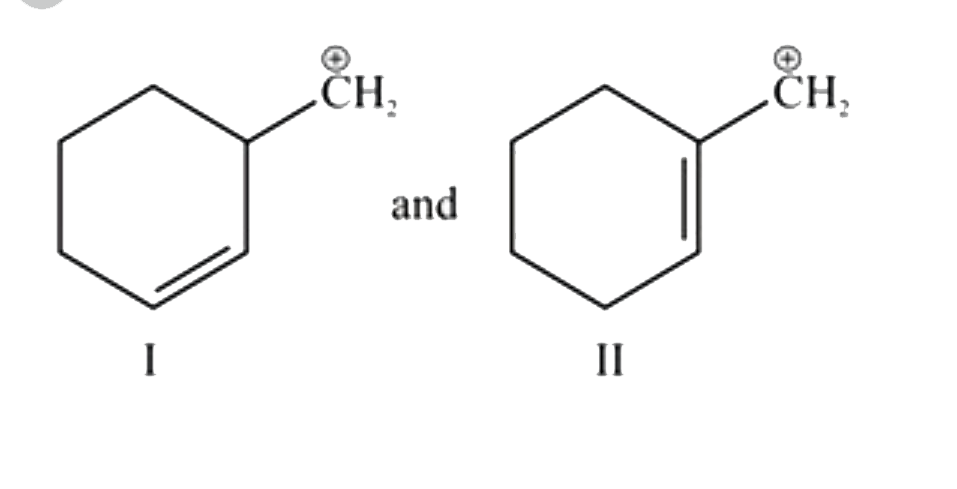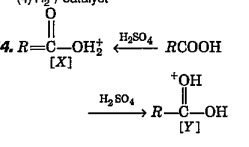In which of the following pairs of carbanion the first one is more stable than correct.
⊙CF3,⊙CCl3
HC≡ ⊙C,H2C=⊙CH

(CH3),⊙C,H3C−⊙CH2
The correct Answer is:B
To determine which of the given pairs of carbanions has the first carbanion more stable than the second, we need to analyze the stability of each carbanion based on their structure and the effects of surrounding groups. Here’s a step-by-step solution:
Step 1: Analyze the first pair (CF3- vs CCl3-)
- CF3-: The carbon is bonded to three fluorine atoms. Fluorine is highly electronegative and has three lone pairs of electrons. This high electronegativity means that fluorine does not want to share electron density with the carbon, leading to increased electron density on carbon.
- CCl3-: The carbon is bonded to three chlorine atoms. Chlorine, being larger and less electronegative than fluorine, can accept some electron density from the carbon due to its 3d orbitals, which allows for backbonding. This backbonding decreases the electron density on carbon, making it more stable.
Conclusion: CCl3- is more stable than CF3-. Therefore, the first carbanion is not more stable in this pair.
Step 2: Analyze the second pair (C≡C- vs C=C-)
- C≡C-: The carbon bearing the negative charge is sp-hybridized, which means it has 50% s-character. Higher s-character indicates greater electronegativity, which stabilizes the negative charge.
- C=C-: The carbon bearing the negative charge is sp2-hybridized, which means it has 33.3% s-character. This lower s-character means it is less electronegative and less stable than the sp-hybridized carbanion.
Conclusion: C≡C- is more stable than C=C-. Thus, the first carbanion is more stable in this pair.
Step 3: Analyze the third pair (C6H11- vs C6H5-)
- C6H11- (Cyclohexyl anion): The carbon with the negative charge is sp3-hybridized, which means it has 25% s-character. The negative charge is localized and not stabilized by resonance.
- C6H5- (Phenyl anion): The carbon with the negative charge is sp2-hybridized, which means it has 33.3% s-character. However, the negative charge can be delocalized over the aromatic ring, providing additional stability.
Conclusion: C6H5- is more stable than C6H11-. Therefore, the first carbanion is not more stable in this pair.
Step 4: Analyze the fourth pair (tert-butyl anion vs ethyl anion)
- tert-butyl anion: The carbon with the negative charge is bonded to three methyl groups. Methyl groups are electron-donating due to the +I effect, which increases electron density on the negatively charged carbon, making it less stable.
- ethyl anion: The carbon with the negative charge is bonded to only one methyl group and one hydrogen. The inductive effect is less pronounced here, leading to a more stable carbanion.
Conclusion: The ethyl anion is more stable than the tert-butyl anion. Therefore, the first carbanion is not more stable in this pair.
Final Answer:
The only pair where the first carbanion is more stable than the second is the second pair (C≡C- vs C=C-).
- CF3-: The carbon is bonded to three fluorine atoms. Fluorine is highly electronegative and has three lone pairs of electrons. This high electronegativity means that fluorine does not want to share electron density with the carbon, leading to increased electron density on carbon.
- CCl3-: The carbon is bonded to three chlorine atoms. Chlorine, being larger and less electronegative than fluorine, can accept some electron density from the carbon due to its 3d orbitals, which allows for backbonding. This backbonding decreases the electron density on carbon, making it more stable.
- C≡C-: The carbon bearing the negative charge is sp-hybridized, which means it has 50% s-character. Higher s-character indicates greater electronegativity, which stabilizes the negative charge.
- C=C-: The carbon bearing the negative charge is sp2-hybridized, which means it has 33.3% s-character. This lower s-character means it is less electronegative and less stable than the sp-hybridized carbanion.
- C6H11- (Cyclohexyl anion): The carbon with the negative charge is sp3-hybridized, which means it has 25% s-character. The negative charge is localized and not stabilized by resonance.
- C6H5- (Phenyl anion): The carbon with the negative charge is sp2-hybridized, which means it has 33.3% s-character. However, the negative charge can be delocalized over the aromatic ring, providing additional stability.
- tert-butyl anion: The carbon with the negative charge is bonded to three methyl groups. Methyl groups are electron-donating due to the +I effect, which increases electron density on the negatively charged carbon, making it less stable.
- ethyl anion: The carbon with the negative charge is bonded to only one methyl group and one hydrogen. The inductive effect is less pronounced here, leading to a more stable carbanion.
The only pair where the first carbanion is more stable than the second is the second pair (C≡C- vs C=C-).
Topper's Solved these Questions
- GENERAL ORGANIC CHEMISTRY IIBook:RESONANCEChapter:GENERAL ORGANIC CHEMISTRY IIExercise:Part-III: Match the Column
Explore 2 Videos
- GENERAL ORGANIC CHEMISTRY IIBook:RESONANCEChapter:GENERAL ORGANIC CHEMISTRY IIExercise:Part-I : Only One Option Correct Type
Explore 22 Videos
- GENERAL ORGANIC CHEMISTRY IIBook:RESONANCEChapter:GENERAL ORGANIC CHEMISTRY IIExercise:Exercise-1
Explore 20 Videos
- GASEOUS STATEBook:RESONANCEChapter:GASEOUS STATEExercise:PHYSICAL CHMISTRY (Gaseous State)
Explore 47 Videos
- GENERAL ORGANIC CHEMISTRY-IBook:RESONANCEChapter:GENERAL ORGANIC CHEMISTRY-IExercise:PART-III : PRACTICE TEST-19
Explore 1 Video
Similar Questions
Knowledge Check
In which of the following pairs of carbanion the first one is more stable than correct.
A⊙CF3,⊙CCl3BHC≡ ⊙C,H2C=⊙CHC D(CH3),⊙C,H3C−⊙CH2
D(CH3),⊙C,H3C−⊙CH2In which of the following pair of compounds the first one is more ractive than second in the same electrophilic aromatic substitution reaction.
Am-xylene, p-xyleneBm-dichlorobenzene,chloro benzeneCBenzene, vinyl benzeneDToluene, isopropyl benzeneIn each of the following pairs of ions in which I ion is more stable than II
AC6H5−⊕CH2IandCH2=CH−⊕CH2IIBCH2I=⊕CHandCH3II−⊕CH2C DCH3−CH−CH3 |CH3−C⊕−CH3IandCH3−N−CH3 |CH3−C⊕−CH3II
DCH3−CH−CH3 |CH3−C⊕−CH3IandCH3−N−CH3 |CH3−C⊕−CH3II
Which of the following is more stable?
View SolutionIn which of the following pairs, first species is more stable than second ?
View SolutionIn which of the following first resonating structure is more stable than the second?
View SolutionIn which of the following first is more basic than second
View SolutionIn which of the following pairs A is more stable than B?
View Solution


